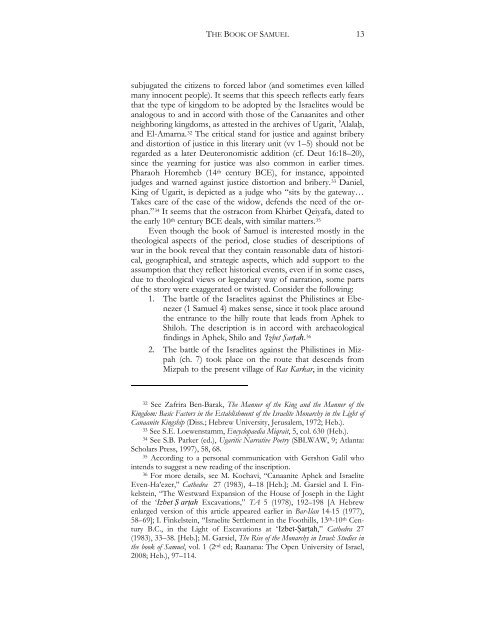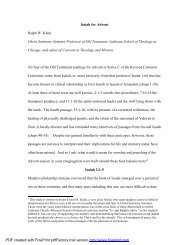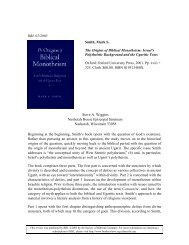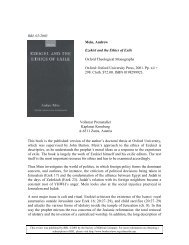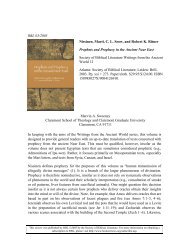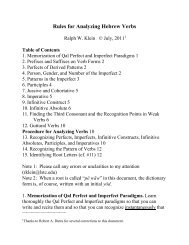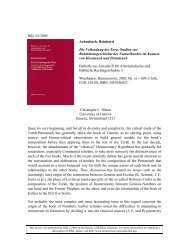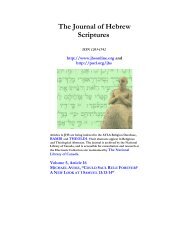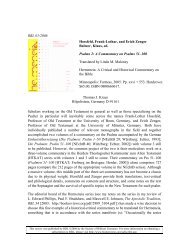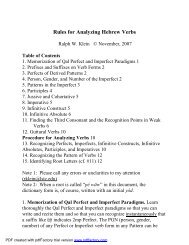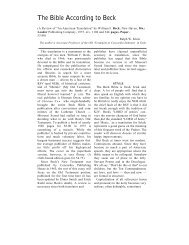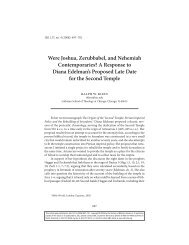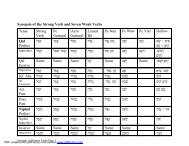The Book of Samuel: Its Composition, Structure and Significance as ...
The Book of Samuel: Its Composition, Structure and Significance as ...
The Book of Samuel: Its Composition, Structure and Significance as ...
Create successful ePaper yourself
Turn your PDF publications into a flip-book with our unique Google optimized e-Paper software.
THE BOOK OF SAMUEL<br />
subjugated the citizens to forced labor (<strong>and</strong> sometimes even killed<br />
many innocent people). It seems that this speech reflects early fears<br />
that the type <strong>of</strong> kingdom to be adopted by the Israelites would be<br />
analogous to <strong>and</strong> in accord with those <strong>of</strong> the Canaanites <strong>and</strong> other<br />
neighboring kingdoms, <strong>as</strong> attested in the archives <strong>of</strong> Ugarit, ’Alalaḥ,<br />
<strong>and</strong> El-Amarna. 32 <strong>The</strong> critical st<strong>and</strong> for justice <strong>and</strong> against bribery<br />
<strong>and</strong> distortion <strong>of</strong> justice in this literary unit (vv 1–5) should not be<br />
regarded <strong>as</strong> a later Deuteronomistic addition (cf. Deut 16:18–20),<br />
since the yearning for justice w<strong>as</strong> also common in earlier times.<br />
Pharaoh Horemheb (14 th century BCE), for instance, appointed<br />
judges <strong>and</strong> warned against justice distortion <strong>and</strong> bribery. 33 Daniel,<br />
King <strong>of</strong> Ugarit, is depicted <strong>as</strong> a judge who “sits by the gateway…<br />
Takes care <strong>of</strong> the c<strong>as</strong>e <strong>of</strong> the widow, defends the need <strong>of</strong> the orphan.”<br />
34 It seems that the ostracon from Khirbet Qeiyafa, dated to<br />
the early 10 th century BCE deals, with similar matters. 35<br />
Even though the book <strong>of</strong> <strong>Samuel</strong> is interested mostly in the<br />
theological <strong>as</strong>pects <strong>of</strong> the period, close studies <strong>of</strong> descriptions <strong>of</strong><br />
war in the book reveal that they contain re<strong>as</strong>onable data <strong>of</strong> historical,<br />
geographical, <strong>and</strong> strategic <strong>as</strong>pects, which add support to the<br />
<strong>as</strong>sumption that they reflect historical events, even if in some c<strong>as</strong>es,<br />
due to theological views or legendary way <strong>of</strong> narration, some parts<br />
<strong>of</strong> the story were exaggerated or twisted. Consider the following:<br />
1. <strong>The</strong> battle <strong>of</strong> the Israelites against the Philistines at Ebenezer<br />
(1 <strong>Samuel</strong> 4) makes sense, since it took place around<br />
the entrance to the hilly route that leads from Aphek to<br />
Shiloh. <strong>The</strong> description is in accord with archaeological<br />
findings in Aphek, Shilo <strong>and</strong> ‘Izbet Ṣarṭah. 36<br />
2. <strong>The</strong> battle <strong>of</strong> the Israelites against the Philistines in Mizpah<br />
(ch. 7) took place on the route that descends from<br />
Mizpah to the present village <strong>of</strong> R<strong>as</strong> Karkar, in the vicinity<br />
32 See Zafrira Ben-Barak, <strong>The</strong> Manner <strong>of</strong> the King <strong>and</strong> the Manner <strong>of</strong> the<br />
Kingdom: B<strong>as</strong>ic Factors in the Establishment <strong>of</strong> the Israelite Monarchy in the Light <strong>of</strong><br />
Canaanite Kingship (Diss.; Hebrew University, Jerusalem, 1972; Heb.).<br />
33 See S.E. Loewenstamm, Encyclopaedia Miqrait, 5, col. 630 (Heb.).<br />
34 See S.B. Parker (ed.), Ugaritic Narrative Poetry (SBLWAW, 9; Atlanta:<br />
Scholars Press, 1997), 58, 68.<br />
35 According to a personal communication with Gershon Galil who<br />
intends to suggest a new reading <strong>of</strong> the inscription.<br />
36 For more details, see M. Kochavi, “Canaanite Aphek <strong>and</strong> Israelite<br />
Even-Ha’ezer,” Cathedra 27 (1983), 4–18 [Heb.]; .M. Garsiel <strong>and</strong> I. Finkelstein,<br />
“<strong>The</strong> Westward Expansion <strong>of</strong> the House <strong>of</strong> Joseph in the Light<br />
<strong>of</strong> the ‘Izbet Ṣ artah Excavations,” TA 5 (1978), 192–198 [A Hebrew<br />
enlarged version <strong>of</strong> this article appeared earlier in Bar-Ilan 14-15 (1977),<br />
58–69]; I. Finkelstein, “Israelite Settlement in the Foothills, 13 th -10 th Century<br />
B.C., in the Light <strong>of</strong> Excavations at ‘Izbet-Ṣarṭah,” Cathedra 27<br />
(1983), 33–38. [Heb.]; M. Garsiel, <strong>The</strong> Rise <strong>of</strong> the Monarchy in Israel: Studies in<br />
the book <strong>of</strong> <strong>Samuel</strong>, vol. 1 (2 nd ed; Raanana: <strong>The</strong> Open University <strong>of</strong> Israel,<br />
2008; Heb.), 97–114.<br />
13


